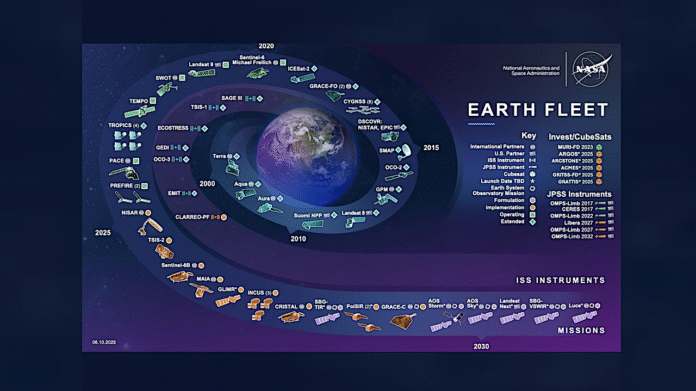
NASA’s Earth Science Fleet — NASA
Keith’s note: This letter from Earth scientists has also been published in Science magazine and is reprinted here with the permission of the authors [Science, 389, 357-358. doi:10.1126/science.adz6100]: “In May, the US administration proposed budget cuts to NASA, including a more than 50% decrease in funding for the agency’s Earth Science Division (ESD) (1), the mission of which is to gather knowledge about Earth through space-based observation and other tools (2).
The budget cuts proposed for ESD would cancel crucial satellites that observe Earth and its atmosphere, gut US science and engineering expertise, and potentially lead to the closure of NASA research centers. As former members of the recently dissolved (3) NASA Earth Science Advisory Committee, an all-volunteer, independent body chartered to advise ESD (4), we warn that these actions would come at a profound cost to US society and scientific leadership.
NASA ESD measurements provide critical information supporting environmental and resource management and community decision-making. In collaboration with the National Oceanic and Atmospheric Administration (5), ESD develops and launches satellites that track weather and pollution. Weather forecasts, including artificial intelligence−based apps on cell phones, rely on this information and will suffer if there are fewer measurements available. ESD measurements are also used in near real-time to diagnose fire risk, support US wildland fire management, and track active fires and their impacts (6).
Furthermore, the data collected by ESD are used to monitor croplands and rangelands, make commodity forecasts, and provide early-warning data for potential crop failures, water availability, and irrigation needs (7). ESD satellite data underpin drought, flood, and hurricane forecasting and are used to monitor water quality, fisheries, and harmful algal blooms (8, 9). This information supports public water management, coastal communities, and commercial and recreational fishing. ESD satellites also track sensitive ecosystems, delivering important data to support wildlife and habitat conservation and management (10).
The US has long been the global leader in Earth-observing satellite technology (11). If the proposed cuts are realized, the US will surrender this leadership to countries in Asia and Europe. Given that the cuts would prevent the US from training and preparing the next generation of the scientific and technical workforce, the consequences would be long-lasting. NASA ESD accounted for just 0.03% of US spending in 2024 (12). This investment returns its
value many times over by improving predictions, by spurring technological innovation and high-tech jobs, and by forging the knowledge of the planet that is needed for short- and long-term planning.
Dylan B. Millet1, Belay B. Demoz2, Jennifer D. Watts3, Robert Wright4
1 Department of Soil, Water, and Climate, University of Minnesota, St. Paul, MN, USA. 2 Department of Physics, University of Maryland Baltimore County, Baltimore, MD, USA. 3 Woodwell Climate Research Center, Falmouth, MA, USA. 4 Hawai’i Institute of Geophysics and Planetology, University of Hawai’i at Mānoa, Honolulu, HI, USA. Email: [email protected]
REFERENCES AND NOTES
- “Trump’s proposed budget would mean ‘disastrous’ cuts to science,” Science, 2 May 2025.
- NASA Earth Science; https://science.nasa.gov/earth-science/
- L. McKenzie, “Agencies closing science advisory committees,” American Institute of Physics, 20 March 2025.
- NASA, Earth Science Advisory Committee; https://science.nasa.gov/researchers/nac/science-advisory-committees/esac/.
- eoPortal, European Space Agency, Joint Polar Satellite System (JPSS); https://www.eoportal.org/satellite-missions/jpss.
- NASA, FireSense project; https://cce.nasa.gov/firesense/.
- S. Avant, “USDA-NASA’s global view of Earth’s soil holds many benefits,” US Department of Agriculture (7 April 2015).
- US Environmental Protection Agency, Cyanobacteria Assessment Network (CyAN); https://www.epa.gov/water-research/cyanobacteria-assessment-network-cyan.
- NOAA Fisheries, Satellite data; https://www.fisheries.noaa.gov/national/science-data/satellite-data.
- B. Burhans, “NASA and WMI partner to support biodiversity,” Wildlife Management Institute, February 2025; https://wildlifemanagement.institute/outdoor-news-bulletin/february-2025/nasa-and-wmi-partner-support-biodiversity.
- US Department of the Interior, “Earth’s resources to be studied from space,” 21 September 1966; https://www.usgs.gov/media/files/1966-earths-resources-be-studied-space-news-release.
- NASA, Fiscal Year 2026 Budget Request (2025); https://www.nasa.gov/fy-2026-budget-request/.
COMPETING INTERESTS
The authors have received NASA funding for research as well as panel and proposal reviews. Published online 10 July 2025 10.1126/science.adz6100






